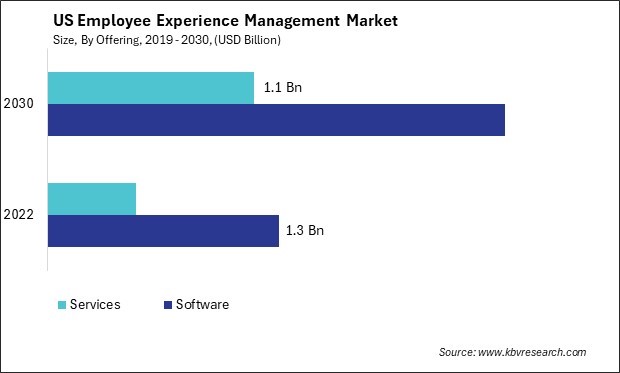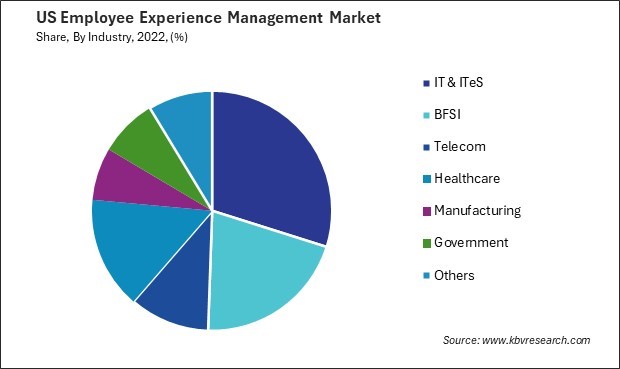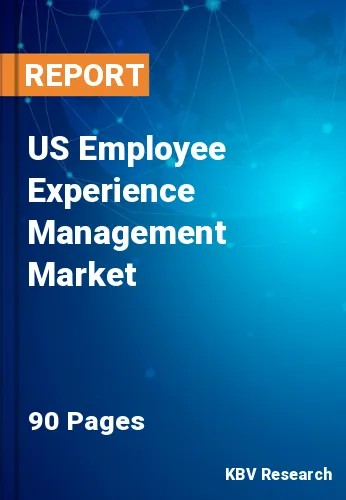The United States (US) Employee Experience Management Market size is expected to reach $3.7 Billion by 2030, rising at a market growth of 9.7% CAGR during the forecast period.
A recent development in the US employee experience management market is adopting technology-enabled solutions to support remote and hybrid work environments. As a result of the COVID-19 pandemic's acceleration of the remote work trend, organizations have made investments in employee experience management (EXM) platforms that facilitate employee engagement, communication, and virtual collaboration. As a result, there has been a surge in demand for EXM solutions that offer virtual team-building activities, wellness programs, and digital feedback mechanisms to support remote and distributed teams' unique needs.

Moreover, in the US market, personalized employee experiences are gaining importance due to the realization that employees have a variety of preferences and needs. Businesses leverage data analytics and AI-driven insights to tailor EXM strategies and initiatives to individual employee profiles, allowing for a more personalized and targeted approach to employee engagement. This focus on personalization is shaping the development of EXM platforms that offer customizable experiences, flexible work arrangements, and personalized learning and development opportunities.
Moreover, there is an increasing integration of EXM with other HR and business systems in the US market as businesses seek to create a seamless and integrated employee experience across the entire employee lifecycle. This integration enables businesses to leverage data from various sources, such as performance management systems, learning management systems, and employee engagement surveys, to gain a holistic view of the employee experience and drive continuous improvement initiatives. As a result, there is a growing demand for EXM platforms that offer robust integration capabilities and interoperability with other enterprise systems.
Companies are recognizing the importance of acknowledging and rewarding employee contributions to boost morale, motivation, and productivity, especially in remote and hybrid work environments. One of the key drivers behind this trend is the shift towards remote work arrangements, which has made it challenging for employers to maintain a sense of connection and recognition among employees. As a result, there is a growing need for digital employee recognition and rewards tools that can facilitate peer-to-peer recognition, manager feedback, and virtual rewards programs. By facilitating the expression of gratitude by employees for their colleagues' endeavors, these tools foster a sense of belonging and camaraderie among members of remote teams.
Furthermore, the evolving workforce expectations, particularly among younger generations, drive the demand for more frequent and personalized recognition experiences. Millennials and Gen Z employees, who make up a significant portion of the workforce, place a high value on recognition and feedback. Employees have an increased propensity to remain attentive and devoted to organizations that give precedence to these elements of the employee experience, such as consistent feedback and acknowledgment of their contributions. As a result, companies are investing in employee recognition and reward tools that can deliver personalized, timely, and meaningful recognition experiences to their employees.
Moreover, the link between employee recognition and organizational performance has been well-established, with studies showing that a culture of recognition can lead to higher levels of employee engagement, satisfaction, and retention. In the current labor market, which is marked by fierce competition and the need for companies to attract and retain outstanding staff, employee rewards and recognition have transformed into strategic tools that enhance employer branding and differentiate the employee experience. As a result, companies increasingly view investment in recognition and rewards tools as a critical aspect of their talent management and retention strategies.
Employee recognition and rewards tools are becoming increasingly in demand, which stimulates innovation in the market through the development of new features and functions that meet the changing requirements of both employers and workers. EXM vendors are increasingly focusing on enhancing the user experience, personalization capabilities, and mobile accessibility of their platforms to make it easier for businesses to implement and manage recognition and rewards programs effectively. In addition, an emerging pattern is the integration of gamified components into employee recognition and rewards systems (EXM solutions), with the intention of increasing employee engagement and interactivity. Hence, all these factors will aid in the expansion of the market.
In light of the IT and ITeS industry's ongoing rapid evolution, which is marked by remote work, talent competition, and digital transformation, organizations in this sector acknowledge the significance of placing employee experience as a top priority in order to engage, retain, and attract top talent. The increasing demand for EXM tools in the IT and ITeS sector of the United States is primarily driven by the transition to remote and hybrid work models. The sector has witnessed a significant increase in remote work arrangements, driven by technological advancements, changing employee preferences, and the impact of the COVID-19 pandemic. This shift has created new challenges in managing and maintaining a positive employee experience across distributed teams. This has increased demand for EXM tools supporting remote collaboration, communication, and engagement.
Furthermore, the talent landscape in the US IT and ITeS sector is highly competitive, with a growing emphasis on attracting and retaining skilled professionals. In light of the sector's ongoing rapid expansion and innovative developments, organizations are placing a greater emphasis on improving the employee experience as a strategic differentiating factor. In this context, EXM tools are of the utmost importance as they empower organizations to establish a work atmosphere that promotes employee contentment, efficiency, and welfare. Thus, these organizations are better able to attract and retain exceptional personnel in a fiercely competitive industry.
Moreover, the IT and ITeS sector's digital nature necessitates using technology-enabled solutions to manage the employee experience effectively. EXM tools offer capabilities such as employee feedback mechanisms, performance management, learning and development programs, and wellness initiatives, all essential for creating a positive and engaging work environment in the digital age. These tools allow businesses to align their employee experience strategies with the evolving needs and expectations of a tech-savvy workforce. Hence, all these factors will aid in the expansion of the market.

The US employee experience management market is characterized by diverse companies offering innovative solutions to enhance employee experience across various industries. These companies provide a wide array of EXM tools and services to improve employee engagement, satisfaction, and productivity in the workplace.
Global technology leaders such as Microsoft, through its Microsoft Viva platform, and Salesforce, with its Salesforce Employee Experience platform, are major players in the US employee experience management market. These companies offer comprehensive EXM solutions that integrate with their broader suite of workplace productivity and collaboration tools, providing businesses with a unified platform for managing the entire employee experience lifecycle, from onboarding to performance management and employee well-being.
In addition to global technology giants, specialized EXM solution providers cater to the unique needs of businesses in the US. These companies focus on delivering targeted EXM solutions tailored to specific industries or organizational requirements. For example, Qualtrics, now part of SAP, offers a comprehensive EXM platform that includes employee feedback, surveys, and sentiment analysis tools. It allows businesses to gather real-time insights into the employee experience and take proactive measures to improve it.
Furthermore, human capital management (HCM) software providers such as Workday and ADP offer EXM modules as part of their broader HCM suites. These companies provide businesses with integrated solutions for managing all employee lifecycle aspects, including recruitment, onboarding, performance management, and employee engagement. Their EXM offerings often include employee self-service portals, social collaboration tools, and performance analytics to enhance the overall employee experience.
Moreover, specialized EXM consulting firms and service providers in the US offer expertise in designing and implementing employee experience strategies. These companies work closely with businesses to assess their current employee experience, identify areas for improvement, and develop tailored EXM solutions that align with their organizational goals and culture. They often provide employee surveys, organizational assessments, and change management support to help businesses optimize their employee experience initiatives.
In conclusion, the US employee experience management market is characterized by global technology leaders, specialized EXM solution providers, HCM software vendors, and consulting firms, each offering unique capabilities to enhance the employee experience. As businesses in the US continue to prioritize employee engagement and well-being, the demand for advanced EXM solutions and services is expected to grow, further expanding the landscape of the employee experience management market in the country.
By Offering
By Industry
Our team of dedicated experts can provide you with attractive expansion opportunities for your business.

